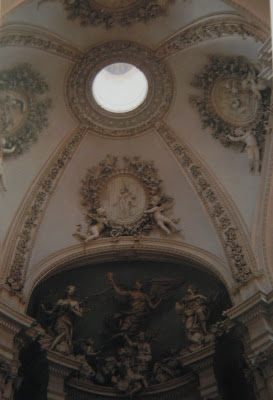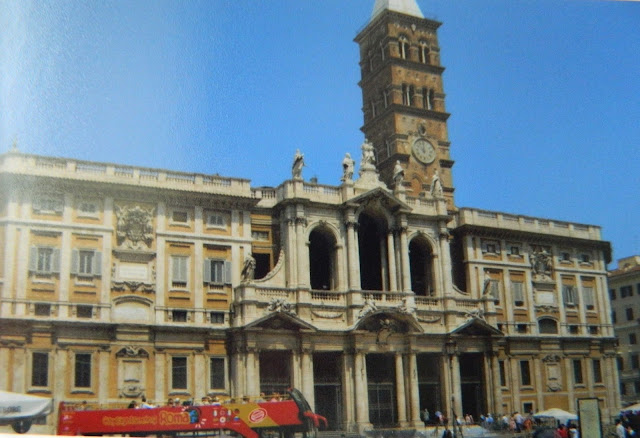Every street, every corner in Rome has a Roman Catholic Church. That's a fact! But which of all those Churches must be visited when in Rome? Visiting all of those Churches in Rome is impossible. It will be like visiting all of the collections in the Louvre Museum in Paris in a few days. So here are my Top 5 Churches in Rome that must be visited. Why? Well, these are Roman Catholic Churches that are like Museums besides being the places of worship.
St John The Lateran
St John The Lateran Cathedral is the First Roman Catholic Church built by Constantine in 311 A.D. Commonly known as the Papal Arch basilica of St John The Lateran. This is the Cathedral Church of the Diocese of Rome and the Official Seat of the Bishop of Rome, who is the Pope.
The interior of the Cathedral. This Cathedral is huge! Notice the gigantic statues of the 12 Apostles on both sides of the Cathedral. My friend and I were lucky to be able to attend mass in the Cathedral to celebrate the Canonization of the Founder of Religious of the Assumption, Saint Marie Eugenie Milleret. This mass was attended by the Nuns of the Religious of Assumption and also their students and Alumnae from all around the world.
The beautiful and ornate ceilings of the Cathedral.
The Main Altar of the Cathedral. Below the Main Altar is the St John statue which contains his relic.
Above one of the ceilings of the Cathedral is the relic of the Last Supper Table of Jesus with the Apostles. The wood table encased in glass with Jesus and the 12 Apostles carved in Gold in front of it. Then an Angel below it.
This is the Chapel near the Main altar where the Holy Last Supper Table relic is displayed. Notice how huge and high the Ceiling of the Cathedral. It is a beautiful Cathedral with frescoes and treasures of the Roman Catholic Church.
The Religious of the Assumption Choir composed of the Nuns and laywomen from all around the World. Here they were singing during the Mass to celebrate the Canonization of Saint Marie Eugenie.
The Piazza in front of the Cathedral. One of the Buildings here is where the Holy Stairs are located.
Apse depicting mosaics from the Triclinium of Pope Leo III in the ancient Lateran Palace
HOLY STAIRS
This is not a Church but equally important to visit and as a place of worship. The worshippers climb the Holy Stairs in their knees. My friend and I climbed these Holy Stairs in our knees while praying. It was quite gruelling but we offered it to the Lord. It was a slow climb up because as you can see, you have to wait for the person in front of you to climb step by step all the way to the top. The original stairs was actually covered in wood to protect it, but in the steps you will see Jesus' blood droppings which were encased in glass. The worshippers can touch that glass to honour the blood of Jesus.
Here is the history of the Holy Steps:
"The Scala Sancta (Holy Stairs), wooden steps that encase white marble steps, are, according to Roman Catholic tradition, the staircase leading once to the praetorium of Pilate at Jerusalem hence sanctified by the footsteps of Jesus Christ during his Passion. The marble stairs are visible through openings in the wooden risers. Their translation from Jerusalem to the complex of palaces that became the ancient seat of popes in the 4th century is credited to Saint Helena, mother of the Emperor Constantine I.In 1589, Pope Sixtus V relocated the steps to their present location in front of the ancient palatine chapel (the Sancta Sanctorum). Ferrau Fenzoni completed some of the frescoes on the walls."
What is on top of the Holy Steps? This Byzantine Icon of Jesus Christ in Gold. This is actually protected by glass so nobody can come closer to it. But the whole experience of climbing the stairs on your knees while saying your prayer and offering the sacrifice to the Lord is a memorable experience.
Santa Maria Maggiore
The Basilica of Santa Maria Maggiore is one of the 5 Basilicas of Rome. It is under the Pope's jurisdiction and land owned by the Vatican. This is the largest Church in Rome dedicated to the Virgin Mother Mary. It is also known as the Lady of the Snows due to a legend on how the foundation of this Major Basilica started:
"During the pontificate of Liberius, the Roman patrician John and his wife, who were without heirs, made a vow to donate their possessions to the Virgin Mary. They prayed that she might make known to them how they were to dispose of their property in her honour. On 5 August, at the height of the Roman summer, snow fell during the night on the summit of the Esquiline Hill. In obedience to a vision of the Virgin Mary which they had the same night, the couple built a basilica in honour of Mary on the very spot which was covered with snow. From the fact that no mention whatever is made of this alleged miracle until a few hundred years later, not even by Sixtus III in his eight-line dedicatory inscription ... it would seem that the legend has no historical basis."
The Piazza in front of the Basilica with the life size statue of the Virgin Mother Mary.
The Nave and High Altar of the Basilica. Apparently, only the Pope and his appointed Arch priests can use the Canopied High Altar.
Underneath the High Altar is the Crypt of the Nativity.
"The Crypt of the Nativity with a crystal reliquary designed by Giuseppe Valadier said to contain wood from the Holy Crib of the nativity of Jesus Christ. Here is the burial place of Saint Jerome, the 4th-century Doctor of the Church who translated the Bible into the Latin Language (The Vulgate)."
This is the Marble statue of the Pope kneeling down in Prayer in front of the Crypt of the Nativity.
The Borghese Chapel.
"The column in the Piazza Santa Maria Maggiore celebrates the famous Icon of the Virgin Mary now enshrined in the Borghese Chapel of the Basilica. It is known as Salus Populi Romani, or Health of the Roman People or Salvation of the Roman People, due to a miracle in which the icon helped keep plague from the city. The icon is at least a thousand years old, and according to a tradition was painted from life by St Luke the Evangelist using the wooden table of the Holy Family in Nazareth."
Sant Alfonso di Liguori
This Church near the Santa Maria Maggiore is the home of the Mother of Perpetual Help original Icon believed to be painted from life by St Luke. This Church is managed by the Redemptionists.
A copy of the Mother of Perpetual Help Icon inside the Church.
The Main Altar where the original Icon of the Mother Perpetual Help is displayed in the Centre High Altar Wall.
Santa Maria Della Vittoria
The Santa Maria Della Vittoria near the Piazza Della Repubblica has the original Sculpture of Gian Lorenzo Bernini of the Ecstasy of Saint Teresa of Avila.
Marble Sculpture of the Ecstasy of Saint Teresa of Avila. According to Dan Brown's, Angels and Demons, Pope Urban VIII rejected the Sculpture as too sexually explicit that he ordered it moved from The Vatican to this Church.
According to Saint Teresa of Avila:
"I saw in his hand a long spear of gold, and at the iron's point there seemed to be a little fire. He appeared to me to be thrusting it at times into my heart, and to pierce my very entrails; when he drew it out, he seemed to draw them out also, and to leave me all on fire with a great love of God. The pain was so great, that it made me moan; and yet so surpassing was the sweetness of this excessive pain, that I could not wish to be rid of it. The soul is satisfied now with nothing less than God. The pain is not bodily, but spiritual; though the body has its share in it. It is a caressing of love so sweet which now takes place between the soul and God, that I pray God of His goodness to make him experience it who may think that I am lying."
The Ceiling of the Santa Maria Della Vittoria.
Outside of the Church is a Statue of St Therese of Lisieux, another Carmelite Nun, in the same Religious order as St Teresa of Avila.
Besides The Vatican and St Peter's Basilica, these Churches and the Holy Stairs included are the top 5 places I suggest must be visited when in Rome. They are not only Places of Worship but also like Museums with great works of Art by great Artists and also have their own stories to tell. But you will only know their stories when you get a chance to visit them. It is worth a visit. Believe me.
Historical Sources: Wikipedia.




























.JPG)
.jpg)







No comments
Post a Comment
I enjoy reading your wonderful comments. Thank you for visiting here.